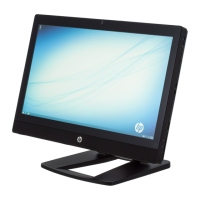Storage
Below is information on common storage features and new features specic to
the HP Z1 G2 Workstation.
Storage features
• 3 - 6Gbps SATA connectors
– One for ODD
– Two for HDDs or SSDs
• Accommodates one 3.5” HDD (with 3.5” drive carrier)
Or
• Two 2.5” SFF HDDs or SSDs (with 2.5” driver carrier)
• 2 - PCIe Mini Card connectors that auto congure as mSATA or mini-PCIe on power up
– One used for Wireless Lan
– One available for mSATA SSD or mini-PCIe card
• Toolless drive bay carriers. One drive carrier is supplied to support the conguration ordered. An optional drive carrier
is available to support the alternate drive conguration.
– The 3.5” drive carrier accepts a single HDD and connects to SATA 0
– The dual 2.5” driver carrier supports two 2.5” HDDs or SSDs connected to SATA 0 and SATA 1
• SATA software emulation modes
– RAID
1
(Default with greatest exibility for most users)
– AHCI (Required when using SEDs)
– IDE (Legacy mode, limited functionality - Not recommended)
• RAID
– Two drive RAID 0 (Striped)
Or
– Two drive RAID 1 (Mirror)
• Intel® Smart Response Technology
2
(SRT) OS Acceleration
• Intel Rapid Storage Technology drivers, RAID conguration Option ROM, and management GUI
(Graphical User Interface)
AHCI and RAID
1
technology
The default SATA emulation mode on HP Workstations is RAID (RAID + AHCI) unless SEDs are installed. If SEDs are
installed, the SATA emulation mode will be set to AHCI. The SATA emulation mode can be changed in BIOS setup
Storage > Storage Options, but changing the mode is not recommended and can result in boot failure or data loss if the
SATA emulation mode is changed after the OS is installed or if a volume already contains data. Always back up your data
before making any storage system changes.
AHCI (Advanced Host Controller Interface)
AHCI is a technical standard developed by Intel for the hardware mechanism that allows software to communicate with
SATA (Serial ATA) devices. It is enumerated as a PCI device and transfers data between system memory and SATA devices.
AHCI provides many benets over the legacy IDE (Integrated Drive Electronics) hard drive interface. Some of the
benets include:
• Elimination of master/slave handling.
• Native Command Queuing (NCQ) that allows a SATA device to internally optimize the order of command execution
for increased performance.
• Trim command support for SSDs which keeps track of les that have been deleted but not erased on the drive.
This improves performance of the drive and helps extend the life of the SSD by preventing unnecessary writes.
Technical white paper | HP Z1 G2 Workstation
10
HP recommends Windows.

